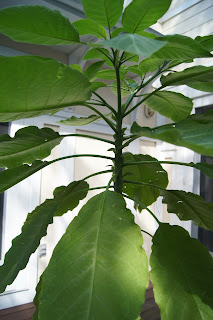 |
| Brugmansia burgeoning on the porch |
We wouldn’t be able to do this as easily without our PotLifter, an ingenious apparatus that winds around large pots and allows us to carry them easily by holding handles. Otherwise I’d be trying to wrap my arms around these awkward, heavy pots myself to carry them up the steps and through the house to their winter quarters.
The reward for this schlepping is blooms now and through the winter. As soon as I brought the Christmas cacti indoors, their buds swelled, and now the plants are covered with flowers.
 |
| Christmas cactus going wild |
Our hisbiscus does the same, responding to its warmer indoor environment with a generous flush of bright red blooms.
 |
| Hibiscus celebrating coming in from the cold |
It flowers through the winter, though less profusely, while thinning its leaves, which turn yellow and drop off one by one. The next summer it fills in again, sprouting more leaves to soak up the sun’s rays.
The reason these plants benefit from time outside is the vast difference in brightness between the indoor and outdoor environments. I found an interesting chart demonstrating this at PsychEducation.org. This web page is about light treatment for depression, but the chart is equally relevant for gardeners. It shows that typical home lighting provides 100 lux, whereas outdoor daylight with a clear sky radiates 10,000 to 20,000 lux.
Light shining through windows is not as strong as outdoor light, and brightness drops off sharply with distance from the window. My shelf of houseplants sits on the north side of the house in summer, so the plants don’t get direct sunlight, which could be as bright as 100,000 lux.
The extra solar energy allows the houseplants to store up lots of sugars they can use to make flowers and leaves through the winter. The brugmansia is our most dramatic example of this process. Brugmansia is a South American tropical shrub with dramatic pendulous trumpet-shaped flowers. Ours makes
 |
| Dramatic brugmansia flowers |
They have an enchanting scent that’s most noticeable at night.
The growing season for this plant is so long that we have to move it indoors before it flowers. Unfortunately it doesn’t rebloom. The show is over for this year.
In winter I can sometimes nurse the brugmansia along next to a large window. If it’s overcome by whitefly, I chop the stem off at the base and banish the pot to the basement. In spring the plant sends up new stems. I choose one as a trunk (this is called pruning for a “standard”). I move it outdoors by Memorial Day, and soon the plant is four feet tall again with large oval-shaped leaves. It’s impressive how much this plant can do with a summer’s worth of sunlight.























